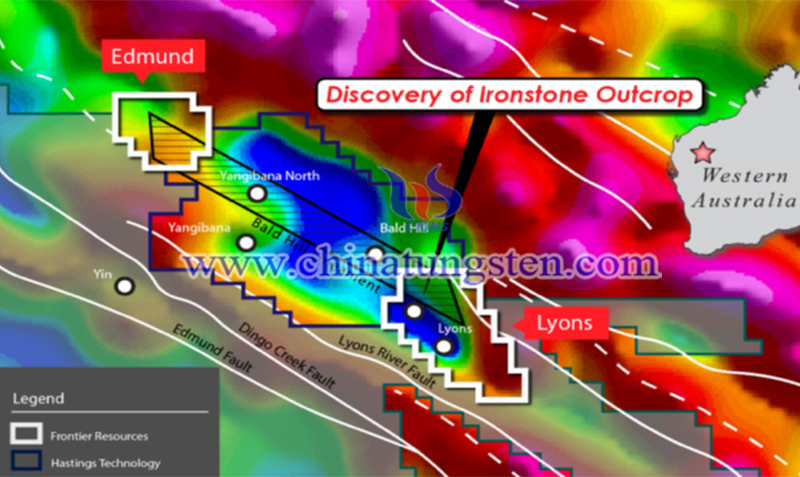Frontier Resources Acquires Rare Earths Near World-Class Deposit
- Details
- Category: Tungsten's News
- Published on Saturday, 04 December 2021 23:43
Mineral exploration company Frontier Resources has discovered rare earths mineralization after sampling its Gascoyne project in Western Australia, which is also near the world-class Yangibana rare earth mine. Assay results show peak levels of total rare earth oxides, or "TREO", including a combined 1,600 ppm of neodymium and praseodymium, elements critical to the production of magnets used in modern electric engines.
Frontier says it has also discovered another potential ironstone outcrop, but has not yet sampled it. frontier's Gascoyne project is located in the approximately 230 square kilometer Durlacher Supersuite formation, which is also home to the adjacent Yangibana rare earths deposit, operated by ASX-listed Hastings Technology Metals.

Hastings, with a market capitalization of approximately $430 million, has drilled a resource of 27.42 million tonnes grading 0.97% TREO at its discovery. The rare earth-bearing Yangibana ironstone is hosted in the Durlacher Supersuite lithology.
Notably, after evaluating a historical EM survey conducted by Geoscience Australia, the Australian government's geoscience agency, Frontier concluded that part of its Gascoyne project could potentially host the Gifford Creek Carbonatite Complex.
Geoscience Australia's EM survey confirms that the Gascoyne project is conducive to hosting significant rare earth oxide mineralization. The Gifford Creek Carbonate Complex is a large mineral system with multiple rare earth deposits identified to date and hosts the world-class Yangibana deposit. From the geophysical data, we can infer the continuity of the Gifford Creek Carbonate Complex on our lands, which is a very exciting result.
In addition, assay results returned from the first round of the rock chip sampling program confirm the presence of rare earth oxide mineralization in the outcropping ironstone, which requires further investigation.
According to the company, its Gascoyne project has seen little previous exploration work because of the shallow alluvium at the site, and Frontier plans to focus its exploration efforts at Gascoyne on neodymium and praseodymium, both of which are used in the production of cell phones, wind turbines, electric vehicles, and military hardware.
Hastings' Yangibana deposit also contains neodymium and praseodymium at a combined composition grade of 0.33%. frontier believes that global consumption of magnet rare earth oxides could quintuple by the end of this decade, from $2.98 billion last year to $15.65 billion by the end of this decade.
The Company recently completed an airborne magnetic radiometric survey of the entire Gascoyne area with the aim of better defining drill targets in the Durlacher Supersuite formation. Sampling was conducted along strike of the newly discovered mineralized ironstone at Gascoyne, and further sampling is planned elsewhere on the property. What’s more the Tolukuma Project owned by the company covers covers 441.72 sq.km located 70km North of the Capital Port Moresby and accessible by air or walking trail.
Frontier Resources has also recently expanded its land holdings in the Gascoyne area by applying for an exploration license called the Mt Clere Project, which includes an additional 350 square kilometers of Durlacher Supersuite lithology. Gascoyne is located in a rare earths rich area and with mineralization confirmed, Frontier has now targeted the project for development.
- Rare Earth Manufacturer & Supplier, Chinatungsten Online: www.chinatungsten.com
- Tungsten News & Prices of China Tungsten Industry Association: www.ctia.com.cn
- Molybdenum News & Price: news.molybdenum.com.cn
- Tel.: 86 592 5129696; Fax: 86 592 5129797; Email: sales@chinatungsten.com



 sales@chinatungsten.com
sales@chinatungsten.com